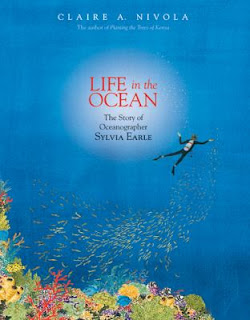Girls Think of Everything: Stories of Ingenious Inventions by WomenWith short entries, Thimmesh shares how women created ingenious inventions ranging from eminently helpful like Liquid Paper or the windshield wiper, to technically complex like the “space bumper” that protects NASA spacecraft and astronauts. The book ends with suggestions and resources to help young women start inventing on their own.
by Catherine Thimmesh, illustrated by Melissa Sweet
Houghton Mifflin, 2000
Your local library
Amazon
Google Books preview
ages 7-12
Life in the Ocean: The Story of Oceanographer Sylvia EarleThis picture book biography captures Sylvia Earle’s life-long love of nature and the ocean. She helped design devices that allowed deep-water dives, lived for two weeks in a deep-sea station, and studied whales, swimming alongside them. Nivola’s rich illustrations help convey the awe-inspiring vastness of the undersea world and Earle’s passion for studying and protecting it.
by Claire A. Nivola
Farrar, Straus & Giroux / Macmillan, 2012
Your local library
Amazon
Google Books preview
ages 5-9
Lives of the Scientists: Experiments, Explosions (and What the Neighbors Thought)Krull tells young readers about the lives of 20 scientists, presenting quick biographical sketches told with verve and humor. She focuses on a diverse range of scientists, including six women, from around the world. An entertaining look at what these men and women were like as human beings, in the laboratory and out of it.
by Kathleen Krull, illustrated by Kathryn Hewitt
Harcourt / Houghton Mifflin Harcourt, 2013
Your local library
Amazon
ages 8-12
Who Says Women Can’t Be Doctors? The Story of Elizabeth BlackwellAlthough Elizabeth Blackwell received 28 rejections from medical schools, she persevered until one accepted her. This lively picture book biography reminds readers that opportunities were different in the 1840s, and that Blackwell helped change this for girls today.
by Tanya Lee Stone, illustrated by Marjorie Priceman
Henry Holt / Macmillan, 2013
Your local library
Amazon
Google Books preview
ages 5-9
Who Was Sally Ride?Sally Ride was an astrophysicist who became the first American woman to fly into space. This biography, part of the popular “Who Was…” series, clearly relates Ride’s life, from her childhood interests in sports and science to her work developing a robotic arm for space shuttles. Inspiring and informative, in an easy-to-read format. I especially like the parallel timelines at the end, which help young readers put Ride’s life in context of world events.
by Megan Stine, illustrated by Ted Hammond
Grosset & Dunlap / Penguin, 2013
Your local library
Amazon
ages 7-11
This article was originally published in Parents Press, September 2015. Many thanks for all of their support. On Monday this week, I shared five fiction stories that spark a love of science, especially for girls.
The review copies came from our school library, public library and home library. If you make a purchase using the Amazon links on this site, a small portion goes to Great Kid Books. Thank you for your support.
©2015 Mary Ann Scheuer, Great Kid Books



























